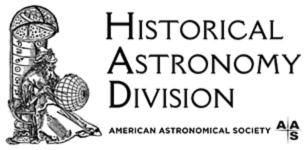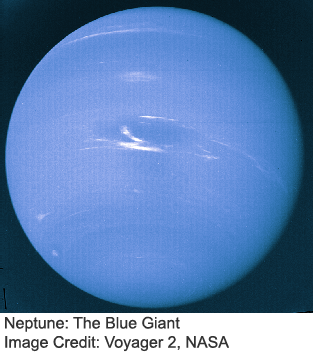This Month in Astronomical History: The Discovery of Neptune
Teresa Wilson United States Naval Observatory
 Each month as part of this new series from the Historical Astronomy Division of the AAS, an important discovery or memorable event in the history of astronomy will be highlighted. This month, we look at the discovery of Neptune
Each month as part of this new series from the Historical Astronomy Division of the AAS, an important discovery or memorable event in the history of astronomy will be highlighted. This month, we look at the discovery of Neptune
 Advancements in astronomy are usually made in two ways: by observing celestial bodies and by new understanding of what is out there. With the 17th century advent of the telescope, mankind no longer relied on excellent eyesight to make observations. But understanding all the new cosmic sights was a different game entirely. Uranus, barely visible to the naked eye, was mistaken for a star dating back to ancient times, and even its "discoverer," William Herschel, thought it was a comet when he first detected it in 1781. Neptune can only be seen with a telescope, but multiple astronomers — from Galileo Galilei in 1612 to John Herschel in 1830 — mistook it for a star.
Advancements in astronomy are usually made in two ways: by observing celestial bodies and by new understanding of what is out there. With the 17th century advent of the telescope, mankind no longer relied on excellent eyesight to make observations. But understanding all the new cosmic sights was a different game entirely. Uranus, barely visible to the naked eye, was mistaken for a star dating back to ancient times, and even its "discoverer," William Herschel, thought it was a comet when he first detected it in 1781. Neptune can only be seen with a telescope, but multiple astronomers — from Galileo Galilei in 1612 to John Herschel in 1830 — mistook it for a star.
After W. Herschel’s haphazard discovery of Uranus in 1781, astronomers tried to predict its orbital motion. By 1821, astronomical tables had been published with predictions of future positions of the new planet, but when astronomers looked to the skies, they determined Uranus was not where predicted. In 1843, John Couch Adams, a newly elected fellow at Cambridge, was convinced that an unseen astronomical body was disturbing it. He used Newton’s laws of gravitation to describe the mass, position, and orbit of the perturbing body. James Challis, director of Cambridge Observatory, and George Airy, Astronomer Royal of the Royal Observatory in Greenwich, supported his work, but did not foresee it leading to any consequential results.
Meanwhile, over on mainland Europe and completely unaware of Adams’ work, the French mathematician Urbain Le Verrier, tackled the same calculations. In November 1845, he presented the flaws in the existing theories of Uranus’ orbit to the Académie des Sciences in Paris. In June 1846, he presented again, this time predicting the position of the perturbing body.
Word of Le Verrier’s prediction, an independent confirmation of Adams’ work, soon reached England. Political tensions between the two nations were running high, and the Brits were determined to discover the purported planet first. Challis, with the support of Airy and J. Herschel, searched in vain for the elusive object. Le Verrier was completely unaware of the race he had started across the Channel and was frustrated that no French astronomer seemed interested in taking up the search. He sent his predictions off to Johann Galle at the Berlin Observatory, who received them on 23 September and immediately began observing the recommended region of the sky. Just after midnight, he discovered Neptune within a degree from Le Verrier’s predicted position after less than an hour of searching. After Galle’s announcement of his discovery, the English astronomers realized Challis had in fact seen the planet a month earlier, but believed it to be a star.
Controversy over who should be credited with the prediction arose between England and France. Unfortunately, Adams’ work had not been made public, so the Royal Society awarded Le Verrier the Copley medal in 1846 for his achievement, without a mention of Adams. While many British astronomers believed Adams should be given equal credit, he himself acknowledged Le Verrier’s priority and Galle’s observation. It was later discovered that both astronomers had over-estimated Neptune’s distance from the Sun, and their predicted orbits only agreed with its actual orbit during the segment in question. Neptune’s discovery was less a triumph of understanding the universe through Newton’s Laws and more another serendipitous observation.
- Adams, J.C. 1851. "On the Perturbations of Uranus (p.265)". UK Nautical Almanac Office.
- Airy, G. B. 1846. "Account of some circumstances historically connected with the discovery of the planet exterior to Uranus". Monthly Notices of the Royal Astronomical Society 7: 121–144.
- Hubbell, J. & Smith R. 1992. “Neptune in America: Negotiating a Discovery.” Journal for the History of Astronomy 23: 4 (261-291).
- Kowal, C. & Drake, S. 1980. “Galileo’s Observations of Neptune.” Nature 287: 311-313.
- Sheehan, W. & Baum, R. 1996. "Neptune's Discovery 150 Years Later." Astronomy 24: 9 (42–49).
Each month is an exciting new adventure into the archives of astronomical history, but before I continue any further, I would appreciate your feedback to ensure my writing is reaching the largest audience possible. Please participate in a brief questionnaire (approximately 10 minutes) about the style and content. You may also submit any suggestions for future topics. Thank you!

